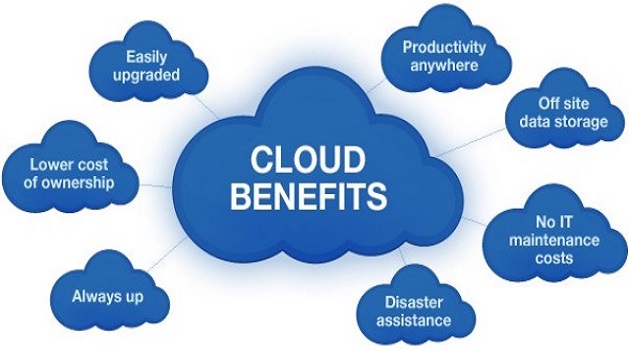Telecom
Why Organizations Need to Adopt a Fresh Approach to Cloud Security in 2023

By Eli Smadja
There is a constant need for vigilance when it comes to cybersecurity within the cloud environment and, while the shift to hybrid working was an unavoidable pivot after the pandemic, it also made it easier for cybercriminals to exploit businesses through their supply chain network.

When comparing the past two years, we have seen a significant increase in the number of attacks per organization on cloud-based networks, which went up by 48% in 2022 compared with 2021.
In addition to vulnerability exploitation attempts, cloud environments have become both the source and target of security incidents and breaches that involve improper access management, sometimes combined with the use of compromised credentials.
In March 2022, the ransomware gang Lapsus$ announced in a statement on its Telegram group that it had gained access to Okta, an identity management platform.
Lapsus$ has a history of publishing sensitive information, often source code, stolen from high-profile tech companies such as Microsoft, NVIDIA, and Samsung. However, this time, the actors claim their target was not Okta itself, but rather its customers.
Following the breach, Okta released an official statement revealing that approximately 2.5% of their customers were affected by the Lapsus$ breach—around 375 companies, according to independent estimates.
Okta, a cloud-based software, is used by thousands of companies to manage and secure user authentication processes, as well as by developers to build identity controls. This effectively means that hundreds of thousands of users worldwide could potentially be compromised by the company responsible for their security.
What’s the reason for the increase in supply chain attacks?
An agile, limitless storage space, the cloud allows users to store sensitive data and undertake complex tasks that cannot be done on traditional servers, which makes them an attractive proposition for cybercriminals.
According to Gartner, 60% of organizations now work with over 1,000 third-party suppliers, all of which are critical to their success but will leave users vulnerable to an unprecedented level of risk. Gartner also predicts that by 2025, 45% of organizations worldwide will have experienced cyberattacks on their software supply chains, three times as many in 2021.
Organizations are also still struggling to sufficiently secure new cloud environments implemented during the pandemic, and simultaneously securing legacy assets which were added during the lockdowns, with no real means to ensure that all of them are secured.
Added to that complexity, this accelerated cloud adoption has exponentially increased the use of third-party applications and the connections between systems and services, unleashing an entirely new cybersecurity challenge.
Cloud security is complicated further by many enterprises using multiple cloud-based solutions, each with specific security settings. With multiple platforms and multiple users, there’s only one outcome – chaos. It is difficult to have visibility into all the integrations between an organization’s cloud applications, as the average enterprise uses 1,400 cloud services.
Why cloud security should be a priority in 2023
Cloud platforms represent a goldmine for malicious actors, especially when you consider the size of many organizations’ cloud supply chain networks. Once a hacker has gained entry, they have carte blanche to act however they choose. This could be anything from injecting malicious content to infect users or wiping all data stored within a particular platform.
Ensuring the security protocols of cloud platforms are set up correctly should be a priority for organizations and their supply chain networks, otherwise, their data and their client’s data are at significant risk.
The misconfiguration of cloud platforms isn’t a new issue, it currently affects millions of users and is often the result of a lack of awareness, proper policies, and security training.
But how can organizations address the issue? Simply increasing employee awareness and training isn’t enough. Conducting meaningful testing alongside robust security measures is the only way to better protect organizations from the threat of cloud supply chain attacks. We practice fire drills, so why not cyberattacks?
Eli Smadja is Security Research Group Manager at Check Point
Telecom
African Women Hit Hardest as Mobile Internet Gender Gap Persists

African women remain among the most digitally excluded globally, with smartphone affordability and digital literacy among the key barriers. New data from the 2025 GSMA Mobile Gender Gap Report, launched recently, reveals a persistent global gender gap in mobile internet use across low- and middle-income countries (LMICs).

It further notes that literacy, digital skills, safety, and affordability of data also remain critical barriers. The report highlights that 885 million women across these regions still do not use mobile internet, with nearly 60% of them living in Sub-Saharan Africa and South Asia.
While mobile internet is the primary way women in LMICs access the internet, offering critical lifelines to health, education, and financial services, the pace of female adoption has stalled, leaving 235 million fewer women than men connected.
Claire Sibthorpe, head of digital inclusion at GSMA, highlighted that the gender gap had narrowed significantly between 2017 and 2020, but progress flatlined in recent years.
Although 2023 brought a slight improvement, restoring the gap to 15%, 2024 saw minimal change, with the gap settling at 14%.
The disparity is most severe in Sub-Saharan Africa, where women are 29% less likely than men to use mobile internet.
“It’s disheartening that progress in reducing the mobile internet gender gap has stalled. The digital divide is driven by deep-rooted socio-economic and cultural factors that disproportionately impact women,” said Sibthorpe.
GSMA projects that closing the gender gap by 2030 could add $1.3 trillion to GDP across LMICs and deliver $230 billion in revenue to the mobile industry.
The report, funded by the UK FCDO, Sida, and the Gates Foundation, stresses the urgent need for targeted investment and policy action to bridge the digital divide and ensure that no woman is left offline.
“The mobile internet gender gap is not going to close on its own. It is driven by deep-rooted social, economic, and cultural factors that disproportionately impact women,” said Sibthorpe.
Telecom
₦800 Billion Infrastructure Plan Set to Boost MTN’s Network Quality Nationwide

In a recent interview, MTN Nigeria reaffirmed that its ongoing infrastructure investment is a strategic step to improve network quality, speed, and nationwide coverage.

Speaking on Beyond the Headlines with Nifemi Oguntoye, Ugonwa Nwoye, Chief Customer and Experience Officer at MTN Nigeria, explained that although public concern is valid, the company undertook several internal cost-efficiency measures before making structural adjustments.
She emphasised that improved investment is critical to fast-tracking improvements across MTN’s network.
Nwoye explained that MTN undertook extensive internal reforms before embarking on structural changes needed to support this scale of investment.
The company completed its phased roll-out of the increase between February and March, ensuring that every existing data plan was below the 50% increase, and most remained below 25%.
She also noted that customers were proactively informed about all changes, particularly when certain legacy plans were retired and replaced with new ones. “We gave customers six to eight weeks’ notice,” she explained.
“This is why it has taken us some time to complete this process, where we let customers know that at a certain date, this particular tariff is not going to exist.”
Nwoye stressed that MTN had exhausted other internal measures before turning to broader structural updates. Now, with the new pricing structure in place, the company is accelerating its investment in infrastructure, spending over ₦200 billion in the first quarter of 2025 alone, a 159% increase from the same period last year. A total capital expenditure of ₦800 billion is planned for the year.
She noted that this investment is a direct outcome of long-term operational restructuring aimed at improving service quality.
She added, “We are investing over ₦800 billion this year alone in our infrastructure. This will translate into better customer experience, reduced congestion, faster internet speeds, and wider network reach.”
This investment will support the upgrade of over 1,000 cell sites and the expansion of more than 2,000 transmission links nationwide.
Nwoye stressed that these upgrades are designed to deliver faster data speeds, fewer dropped calls, and broader network reach, especially in underserved areas.
She acknowledged the public’s expectations for immediate service improvements but emphasised that large-scale infrastructure takes time to deploy.
Nonetheless, MTN expects customers to begin experiencing visible improvements in network performance by the second half of the year.
In a sector where service quality and customer satisfaction are closely watched, MTN maintains that its ongoing investments are not merely capital commitments but vital enablers of improved digital experiences across Nigeria.
Telecom
Remita’s Bold Leap: Nigeria’s Fintech Giant Expands Across Africa

Remita, the pioneering Nigerian payment technology platform developed by SystemSpecs, is charting a bold new course with its planned expansion into markets across Africa.

What began as a payroll feature in an HR application has now become a robust ecosystem processing over ₦60 trillion annually—one that stands on the verge of reshaping the continent’s fintech landscape, Mr. Deremi Atanda, Managing Director/CEO of Remita Payment Services Limited, says in an exclusive interview that will grace the cover of eGovernance Nigeria Magazine.
The forthcoming edition of eGovernance Nigeria Magazine, a publication of the Technology Times media brand owned and operated by Digital Transformation Media Limited (DTML), will spotlight this extraordinary journey, and present Remita’s evolution as an inspiring tale that informs, educates, and entertains readers about indigenous innovation making global strides.
“We’ve become an ecosystem of rails, products, and services—robust,” Atanda, Managing Director/CEO of Remita explains during the exclusive interview with eGovernance Nigeria Magazine.
“Layering all of that with the many different customers we’ve had, typically every year we process in excess of maybe ₦60 trillion in transactions in Nigerian Naira. And this can only grow, especially as we begin to think of a vibrant Pan-African expansion. We’re at the fringe of that.”
In a compelling narrative that mixes grit, vision, and innovation, Atanda recounts Remita’s early days. “What many people know today as Remita actually started out as a feature within our HR/payroll application.
“You process salaries, and you just want to pay—so just remit salaries. And by the way, that’s where the name ‘Remita’ came from: Remittance. We just took out one ‘T’ and left it at ‘A.’”
Even the company’s logo carries symbolism of that transformation. “I don’t know if you’ve seen our logo—it has three dots, in ascending size. There are many stories in that logo. It started as a feature, and then we brought it out as a product,” Atanda explains.
Yet the road was not without its bumps. “The first time we brought it out as a product was to bid for the National Pension Commission. This was in 2004, with the PenCom Act.
“We packaged this into a product in less than two weeks to take care of end-to-end pensions as it was conceived. Trust me, that vision is still viable today. But we lost that bid.”
Undeterred, SystemSpecs pivoted. “We went back and said, ‘What do we do with this asset?’ If it’s not going to work for pensions, let it become a product. And that’s how we renamed pensions.com.ng as Remita, and it became a product.”
As demand grew, Remita expanded beyond payroll. “Some people want to do their own payroll and just make payments, so let them have a site to go to. Later, it evolved into not just payroll payments. People wanted to do other types of payments. If you want to do non-salary payments, you go to Remita,” he says.
Today, Remita has fully matured into a standalone company. “So those three things—feature, product, company. That’s been the evolution.” With a Tier 1 licence from the Central Bank of Nigeria, Remita is now a fintech powerhouse. “We do switching, we do payment service provisioning, we do super agency, we do terminals—everything you can think about. We provide some basic services within the payment space, including payment service advisory.”
A lesser-known chapter of Remita’s growth includes building Nigeria’s first account-to-accountswitch. “Before TSA, we had built a rail—Nigeria’s first account-to-account switch, worked with all the banks. Not many people know that story. Account-to-account. The front of it, the application, and the rail—first of its kind.”
On the pivotal Treasury Single Account (TSA) deal with the Federal Government of Nigeria, Atanda reveals, “TSA was a happenstance. The government was looking to solve a problem, and we were looking to get regulated. It’s that term people use—when they say ‘luck,’ it’s just preparation meeting opportunity.”
Reflecting on the journey, he adds, “These have been some of those moments where you feel validated, where the visionary leadership that set the business up feels the vision is being realized.”
Today, Remita employs over 300 Nigerians and looks beyond its home shores. “The vision is huge, and we’re committed to that. So, we see exponential growth, and we’re positioning for that.”
Mr. Shina Badaru, Chairman of DTML, says Remita’s story is an inspirational example of local innovation with global relevance. “Remita’s success highlights the critical role of indigenous technology solutions in redefining Africa’s digital economy,” he says.
“As the cover story of the next issue of eGovernance Nigeria Magazine, we aim to showcase how homegrown innovation is not only solving problems locally but is also poised to transform markets across the African continent.”
According to Badaru, “Remita’s inspiring journey connects seamlessly with our article of faith to continue to showcase Nigeria’s growing contributions to the global technology industry.”
eGovernance Nigeria Magazine is a flagship DTML platform with operations across print, digital, TV, events, and e-commerce channels.
“This feature not only celebrates Remita’s evolution,” Badaru adds, “but also signals a pivotal shift in the narrative of Nigerian and African technology—from survival to scale, from local impact to continental transformation.”
As Remita sets its sights on Africa, it is poised to bring financial inclusion, digital infrastructure, and innovative fintech solutions to new and underserved markets. With a strong foundation and visionary leadership, the company is ready to deliver the next phase of its remarkable journey.

 General News2 days ago
General News2 days agoNITDA Advocates Strategic Partnership in Research to Unlock Nigeria’s Digital Potential

 News3 days ago
News3 days agoStakeholders Seek Strengthening of Digital Infrastructure @ IoT West Africa

 Telecom3 days ago
Telecom3 days agoAirtel Introduces Full Shopping Experience Within My Airtel App

 General News3 days ago
General News3 days agoLagos Slush’D 2025 To Promote Creativity among Start-ups

 General News3 days ago
General News3 days agoJumia Expands Delivery Service to Nigeria

 E-Business3 days ago
E-Business3 days agoQ1 2025 .ng Domain Name Statistics Reflect Nigeria’s Advancing Digital Landscape

 Telecom2 days ago
Telecom2 days agoGSMA Urges Governments to Prioritise Affordable Spectrum Costs to Support Global Digital Growth

 Telecom2 days ago
Telecom2 days agoTelcos Worry over Possible 5 Percent Tax Return




















